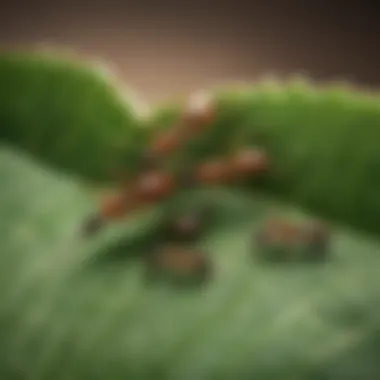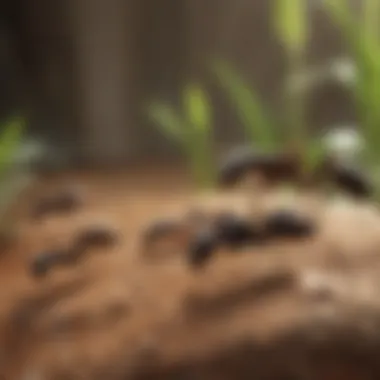Understanding Tiny Ants in the House: Impact and Control


Intro
Tiny ants are a common sight in many households, yet their presence often raises questions. What species are invading our homes? Why do they choose certain locations? How can one effectively manage and prevent these infestations? Understanding tiny ants requires delving into their biological and behavioral characteristics, their ecological roles, and effective control methods that can be implemented. This guide aims to provide a thorough insight into tiny ants, their habits, and practical methods to deal with them.
Animal Species Profile
Prologue to the animal species
Tiny ants encompass various species that can significantly impact domestic environments. The most encountered species include the Argentine ant, Odorous house ant, and the Pharaoh ant. Each species exhibits unique traits that influence their choice of habitat and behavior.
Physical characteristics and appearance
The physical attributes of tiny ants can vary, but many share common features. They are usually small, measuring between 1/16 to 1/4 inches in length. Their bodies are segmented, often shiny, and may present various colors from black to brown or reddish tones. Antennae are typically elbowed, and they possess mandibles which they use for various tasks, including digging and carrying food.
Natural habitat and distribution
Tiny ants generally favor moist environments and often nest near food sources. They can be found in urban settings, gardens, and within buildings. The Argentine ant, for instance, is prevalent in subtropical and temperate regions, while the Odorous house ant tends to thrive indoors, especially in kitchens.
Behavior and social interactions
Ants are social insects, living in colonies that can contain thousands of individuals. They work collaboratively to gather food, defend their nest, and care for their young. Communication among ants occurs through pheromones, which help them locate resources and alert others of threats. Observing their interactions can provide insights into their complex social structures.
Effective Control Measures
Preventing ant infestations requires understanding their habits and proactive measures:
- Seal entry points: Identify and block cracks and crevices in walls and foundations.
- Maintain cleanliness: Keep food stored securely and minimize crumbs and spills.
- Use bait traps: Employ species-specific bait to effectively target the infestation.
"Understanding the species present in your home is crucial to effective management."
Preventive strategies to avoid future infestations
To avert future ant invasions, homeowners can adopt several preventive tactics:
- Regularly inspect for signs of infestation.
- Remove standing water and fix leaks that may provide a habitat for ants.
- Keep regular gardening and landscaping practices to discourage nests in proximity to the home.
The End
Tiny ants may seem inconsequential, but their presence in the home can signify larger ecological dynamics. By exploring their characteristics, behaviors, and implementing proper control strategies, individuals can manage infestations while appreciating the role these insects play in the ecosystem. Understanding these aspects fosters a better relationship with nature and promotes informed decision-making.
Prelude to Ant Infestations
Ant infestations in homes are more than just a minor annoyance. Tiny ants can compromise the comfort of domestic spaces and lead to potential damage. Addressing infestations involves recognizing the species involved, understanding their habits, and implementing effective control measures. This understanding is valuable for homeowners and enthusiasts alike, providing insights into why these insects invade our living spaces. By gaining this knowledge, individuals can avoid complacency, ensuring their home remains free from unwanted visitors.
Defining Tiny Ants
Tiny ants, often referred to as household ants, vary in size but are typically identified by their small physical dimensions, usually ranging from one-eighth to one-quarter of an inch long. The sheer number of species recognized in North America makes them a diverse group. This diversity introduces complexity in identification and management. Understanding the characteristics of tiny ants will allow homeowners to create tailored strategies for control and prevention, fostering a proactive approach to ant management.


Common Species in Homes
Ants are social insects that form colonies. In domestic environments, several species are predominant.
Odorous House Ants
Odorous house ants are particularly notorious for their rapid spread and the unique, musty smell they emit when crushed. This aroma helps in identifying their presence. Odorous house ants thrive in various environments, often found in kitchens and near food sources. Their behavior highlights their opportunistic nature, responding quickly to food attractants often left by humans. The key advantage of this species is how easily detectable they are, aiding homeowners in making swift identification and subsequent action. However, their ability to establish large colonies poses challenges that need focused control measures.
Carpenter Ants
Carpenter ants are larger compared to other tiny ants and are recognized by their black or bicolored bodies. They do not consume wood but instead tunnel through it to establish nests. This behavior can lead to significant structural damage in homes, particularly in wooden frames or beams. The key characteristic of carpenter ants is their nesting preferences, which often align with areas of high moisture. Homeowners must remain vigilant about preventing moisture build-up, as it attracts these ants. The disadvantage lies in their nesting habits, which necessitate professional assistance for removal in cases of severe infestations.
Pavement Ants
Pavement ants derive their name from the common habit of nesting under sidewalks, driveways, and patios. They have small, dark bodies and exhibit a distinctive two-segmented waist. Pavement ants are seen foraging for food, often raiding homes where they become a nuisance. Their colonies can become extensive, which allows rapid reproduction. Recognizing their trails helps in effective control. The presence of these ants indicates potential issues with cleanliness or food containment, highlighting the importance of maintaining a clean home environment to mitigate their invasion. However, their relatively straightforward management makes them less of a concern when addressed promptly.
Understanding the various species of tiny ants and their behaviors is essential. Being informed allows homeowners to take precise action steps in controlling ant populations, as well as taking preventative measures to avert future infestations.
Why Tiny Ants Choose Your Home
Understanding why tiny ants invade homes is crucial for effective management and prevention. Tiny ants are not merely a nuisance; their presence can indicate underlying issues regarding cleanliness or structural vulnerabilities. Recognizing what attracts these insects allows homeowners to adopt measures that address the root cause of the problem rather than simply treating the symptoms.
Food Sources
One of the primary reasons tiny ants are drawn to homes is the availability of food. These insects are foragers and have an innate drive to seek out sustenance. While they may consume a wide range of foods, some favorites are sweet substances and protein-rich materials. Common food sources include:
- Crumbs from meals or snacks
- Unsealed food containers
- Spills on kitchen counters or floors
- Pet food left out for long periods
Additionally, sugary substances, such as honey, fruit juice, and syrups, are particularly attractive to many ant species. It is essential for homeowners to keep their living areas clean and organized to mitigate access to potential food sources. Regular cleaning routines and proper food storage play a significant role in deterring these tiny invaders from making your home their pantry.
Shelter and Nesting Preferences
Tiny ants seek shelter in homes that provide safe havens from predators and environmental threats. They prefer locations that offer both warmth and moisture, attributes typically found in domestic settings. Common nesting sites include:
- Wall voids and cracks
- Inside insulation or behind baseboards
- Underneath sinks or around plumbing fixtures
Ants are often drawn to areas that have easy access to food and water. The presence of moisture—due to leaks or high humidity—can amplify this attraction. Understanding these preferences can help homeowners identify potential nesting sites and take proactive measures to seal them off. Keeping areas dry and minimizing clutter will reduce suitable habitats for nesting and ultimately decrease the likelihood of an infestation.
"By recognizing food sources and shelter preferences, one can effectively create an environment less hospitable to tiny ants."
In summary, the reasons tiny ants choose your home relate significantly to food availability and shelter conditions. Taking action to minimize these attracting factors can be an effective strategy in managing and preventing ant infestations.
Identifying an Ant Infestation
Identifying an ant infestation is a crucial step for homeowners. Early recognition can play a significant role in mitigating problems before they escalate. Tiny ants can often be discreet, making it easy to overlook the early signs of an intrusion.
There are specific elements to consider when identifying an infestation. Knowledge of their behavior and patterns not only aids in detection but also impacts the effectiveness of control measures. Awareness of the signs and severity can inform proper intervention methods, making it essential to focus on these aspects.


Signs of Infestation
Physical Sightings
Physical sightings are one of the primary indicators of an ant infestation. Noticing ants inside the home is often the first alert. The key characteristic of physical sightings is that they provide direct evidence of an ant presence. This makes it a popular method for identification. Ants may be seen crawling on surfaces, appearing in kitchens, or forming clusters in corners.
A unique feature of physical sightings is the varied appearance of ants. Different species exhibit distinct colors and sizes, which can assist in the identification process. Recognizing these differences can lead to better-targeted control strategies. However, a disadvantage is that some ants tend to be elusive. Thus, sightings might be sporadic, leading to potential underestimation of the problem.
Trails and Patterns
Trails and patterns are another substantial aspect of confirming an infestation. Ants have a remarkable capability to create visible paths when foraging for food. The key feature of trails is the pheromone markers they leave behind, which direct other ants. This method of navigation is beneficial as it indicates not just the presence but the activity level of the colony.
The unique aspect of trails is that they can lead back to a nest. Observing these trails can help locate the source of the problem. The advantage of using trails as a sign of infestation is their clarity. They provide a clear, logical path that can be followed. However, there can be disadvantages as well. For example, if trails are only seen outdoors or in less frequented areas, it may suggest a more extensive infestation that’s harder to control.
Determining Severity
Determining severity is crucial for formulating an effective response. It involves assessing both the number of sightings and the extent of trails observed. A higher number of individual ants typically suggests a larger or more established infestation. By understanding the severity, one can choose the right control measures. This step is pivotal for ensuring that the methods employed are appropriate and do not exacerbate the situation.
Health and Environmental Considerations
Understanding the health and environmental considerations related to tiny ants is essential for homeowners and enthusiasts alike. Tiny ants, while often overlooked, are not just simple pests; they play significant roles in ecosystems. This section delves deeper into the potential health risks posed by these ants and their ecological roles that contribute positively to the environment.
Potential Health Risks
Tiny ants can carry various pathogens that may pose health risks to humans. While many species do not inflict severe harm, some, like the Carpenter Ant, can lead to structural damage in homes, contributing to long-term consequences. Ants can also invade food supplies, which raises food safety concerns. Ingesting food contaminated with ant saliva or feces can result in allergic reactions or gastrointestinal issues. It is crucial to monitor the presence of these ants to protect human health, especially in kitchens and food storage areas.
Ecological Role of Ants
Decomposition
Ants play a vital role in the process of decomposition. By breaking down organic materials, they help recycle nutrients back into the soil. This contribution is essential for maintaining soil fertility and promoting plant growth. Ants consume decaying organic matter, which aids in its breakdown. The agitation caused by their movements helps to aerate the soil, fostering a healthier ecosystem. This factor emphasizes their importance not just as pests but as contributors to ecological health.
Seed Dispersal
Ants also engage in seed dispersal, which is critical for plant propagation. They transport seeds to their nests, where some seeds germinate. This behavior enhances biodiversity in ecosystems by aiding in the spread of various plant species. Ants often prefer seeds with nutritious elaiosomes, providing a food source for themselves while propelling plant growth. This mutualistic relationship between ants and plants offers advantages for both, showcasing ants' ecological importance beyond mere pest status.
In summary, while tiny ants can sometimes pose health risks in the home, their ecological roles in decomposition and seed dispersal highlight the need for a balanced view of these insects. Understanding their contributions helps in making informed decisions about pest management.
This understanding of health risks and ecological benefits informs homeowners on how to approach tiny ant situations effectively.
Effective Control Strategies
Controlling tiny ants in the house is crucial for maintaining a healthy and comfortable living environment. The presence of ants can lead to frustration for homeowners. Effective control strategies can help eliminate infestations while also preventing future re-occurrences. This section explores various methods of control, focusing on non-chemical options and chemical solutions, allowing readers to assess which methods might best suit their needs.
Non-Chemical Methods
Physical Removal


Physical removal is a direct approach to managing tiny ants. It involves eliminating ants through manual efforts, such as vacuuming them up or sweeping them away. This method is particularly beneficial in the early stages of an infestation. Homeowners can quickly address the issue without using harsh chemicals. One key characteristic of physical removal is that it provides immediate results; you can visibly see ants being cleared away.
However, there are some unique features and considerations. For instance, this method does not target the nest, meaning that if the source is not addressed, ants may return soon after removal. Its advantages include avoiding exposure to potentially harmful chemicals, which makes it a popular choice for those with pets or children. The disadvantage lies in its temporary nature, as it requires ongoing effort without solving the underlying issue in a permanent way.
Natural Deterrents
Natural deterrents serve as a preventive measure to keep ants at bay. Common options include vinegar, peppermint oil, and diatomaceous earth. These substances can disrupt ant trails and discourage them from entering your home. The key characteristic of natural deterrents is that they are often safe for humans and pets, posing little risk of toxicity.
This strategy is appealing due to its eco-friendly nature. Users can create solutions easily from household products, making it a cost-effective choice. The unique feature is their ability to work without chemicals, which aligns with the values of individuals seeking sustainable living conditions. However, natural deterrents may not be as effective as synthetic options and might require frequent application to maintain efficacy.
Chemical Options
Chemical options are often the go-to for severe infestations. Products such as ant baits, sprays, and granular insecticides are designed to specifically target ant populations. They often contain active ingredients that disrupt the ants' nest or reproductive capabilities. These chemical solutions can provide quick results, leading to reduced visibility of ants in a short amount of time.
While convenient, chemical options come with several considerations. Homeowners should carefully read labels, following the manufacturer’s instructions for safe and effective application. It is important to account for potential health risks, especially in homes with pets and children. The primary advantage is their efficiency, but the disadvantage is the necessity for caution in their use, as improper application can lead to unintended consequences.
Preventing Future Infestations
Preventing future ant infestations is crucial for homeowners aiming to protect their environment. Tiny ants can quickly become a persistent problem. Once they find access to food and shelter, their colonies will thrive. It is essential to understand the methods for blocking their entry and maintaining a clean atmosphere. This approach reduces the risk of recurrence.
Sealing Entry Points
Tiny ants often invade homes through various small openings and cracks. Sealing these entry points is one of the most effective methods of prevention. Here are some practical steps to secure your home:
- Inspect all potential entry points. This includes windows, doors, and any cracks in the foundation.
- Use caulk or expandable foam to fill gaps. These materials provide a strong barrier against tiny intruders.
- Check for gaps around pipes and wires. If any are found, apply appropriate sealing products.
- Install door sweeps at the bottom of doors. This helps to close any openings allowing ants to enter.
By effectively sealing entry points, you can significantly limit the accessibility of your home to these pests.
Maintaining Cleanliness
Another vital factor in preventing tiny ant infestations is cleanliness. Keeping your living space tidy and free of food sources minimizes the attraction for pests. Here are essential practices to consider:
- Keep food sealed in airtight containers. Ants can detect food from a distance, and even crumbs can entice them.
- Clean up spills immediately. This includes both food and liquid spills, as they can leave residues that attract ants.
- Ensure regular garbage disposal. Keep waste in secure bins and take out the trash frequently.
- Eliminate standing water. Ants require water to survive, so be sure to fix leaky faucets and clean up water build-up.
Following these cleanliness tips will help you create a less inviting environment for tiny ants.
Maintaining cleanliness not only deters tiny ants but also promotes a healthier living environment overall.
By implementing these strategies, you can effectively reduce the likelihood of future ant infestations in your home.
Finale
In this article, we explored the intricate relationship between tiny ants and domestic environments. The presence of these insects in our homes can provoke a variety of reactions, from curiosity to concern. Understanding why tiny ants invade our spaces is crucial for effective management and prevention. The examination of species, food sources, nesting preferences, and potential health risks allows homeowners to make informed decisions.
Recap of Key Points
- Tiny ants, including odorous house ants, carpenter ants, and pavement ants, are common invaders in households.
- These ants are attracted by various food sources, including sugary substances and grease. Their nesting preferences often lead them indoors, seeking shelter.
- Identifying signs of infestation is essential for prompt action. Common signs include physical sightings and visible trails.
- Health risks, while generally mild, are notable. Ants can contaminate food and surfaces. Additionally, certain species like carpenter ants can cause structural damage.
- Effective control strategies combine both non-chemical and chemical methods, allowing for tailored solutions. Preventive measures, such as sealing entry points and maintaining cleanliness, are vital in reducing future risks.
Final Thoughts on Living with Ants
Living with ants does not need to be a distressing experience. By fostering an understanding of these insects, one can learn to coexist, as they play important ecological roles. It is essential to respect their presence while managing infestations in thoughtful ways. Awareness and education are the key elements in maintaining a balanced environment, protecting your home, and acknowledging ants as a part of the natural ecosystem. Awareness also informs decisions about sharing our space respectfully.
By understanding tiny ants, homeowners prepare for potential infestations while appreciating the ecological significance these creatures bring to our world.







